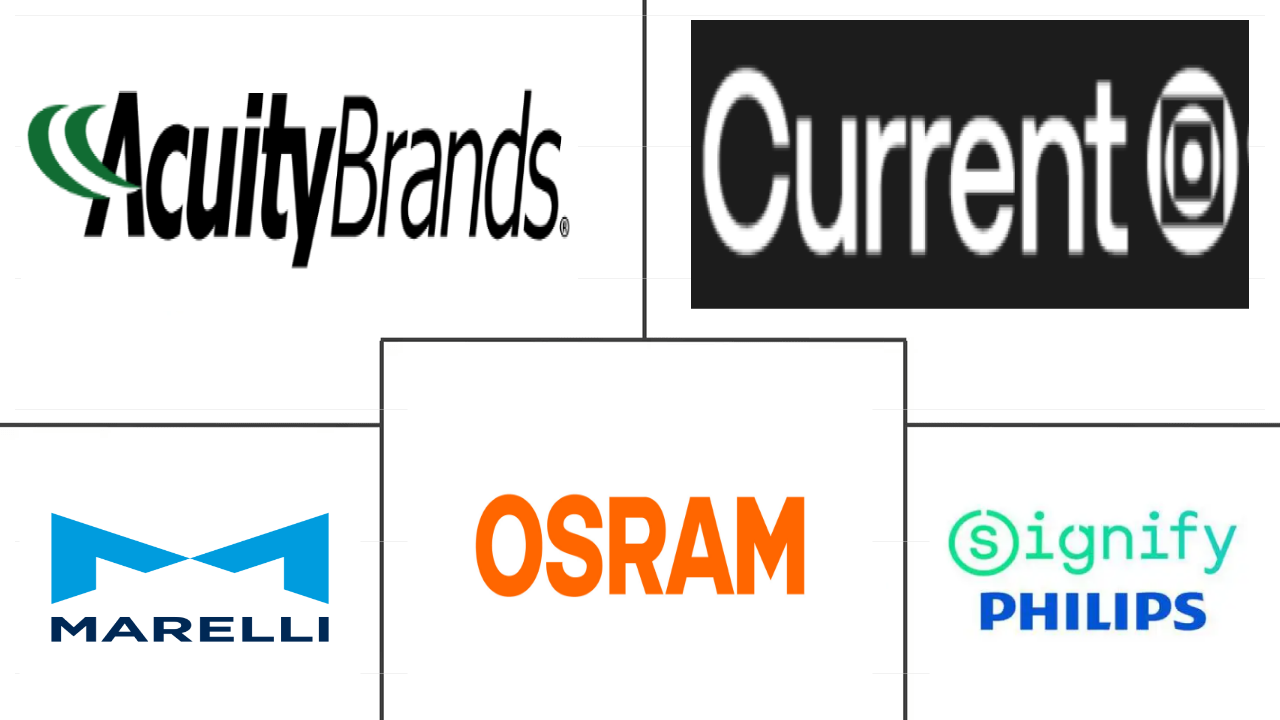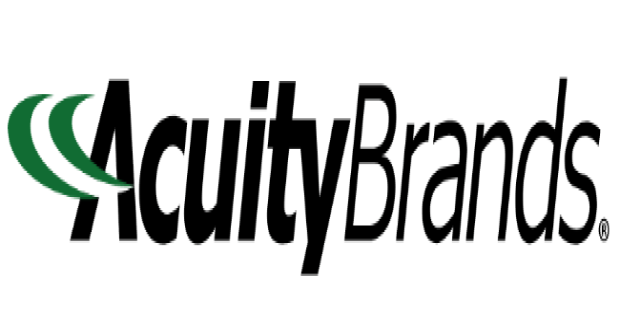Market Size of us led lighting Industry
|
|
Study Period | 2017 - 2030 |
|
|
Market Size (2024) | USD 8.89 Billion |
|
|
Market Size (2030) | USD 11.06 Billion |
|
|
Largest Share by Indoor Lighting | Commercial |
|
|
CAGR (2024 - 2030) | 3.72 % |
|
|
Fastest Growing by Indoor Lighting | Industrial and Warehouse |
Major Players |
||

|
||
|
*Disclaimer: Major Players sorted in no particular order |
US LED Lighting Market Analysis
The US LED Lighting Market size is estimated at 8.89 billion USD in 2024, and is expected to reach 11.06 billion USD by 2030, growing at a CAGR of 3.72% during the forecast period (2024-2030).
8.89 Billion
Market Size in 2024 (USD)
11.06 Billion
Market Size in 2030 (USD)
-0.23 %
CAGR (2017-2023)
3.72 %
CAGR (2024-2030)
Largest Segment by Automotive Utility Lighting
35.10 %
value share, Headlights, 2023
The passenger car category in 2021 accounted for 1.7 million units, followed by commercial vehicles with 8.3 million units in 2022. This corresponds to more use of headlights.
Largest Segment by Automotive Vehicle Lighting
95.80 %
value share, Passenger Cars, 2023
The passenger car market is expected to increase in EVs. In 2022, 5.7% of US car sales were fully electric car sales. The overall sales increased 43% in 2022 compared to 2021.
Largest Segment by Indoor Lighting
65.29 %
value share, Commercial, 2023
In the United States, many countries invested in commercial real estate, including Canada with cross-border flows of around USD 19 billion in 2021.
Largest Segment by Outdoor Lighting
85.55 %
value share, Public Places, 2023
To improve rail logistics and passenger services, the US government provides funding for railway projects throughout the country.
Leading Market Player
33.34 %
market share, ACUITY BRANDS INC., 2022

Acuity Brands is one of the largest lighting manufacturers in the US. Digital retailers, lighting showrooms, and energy service organizations are among the primary customers.
The increasing disposable income, government investments, and rising commercial construction in the region drive the growth of led lighting market
- In terms of value share, in 2023, commercial accounted for the majority of the share, followed by industrial and warehouse, and residential. The main factors contributing to the growth of the industrial sector's resilience are changes in labor force levels in China, less regulatory burden for US production than European counterparts, and greater vitality of manufacturing income relative to the United States Gross Domestic Product.
- In terms of volume share, in 2023, commercial accounted for the majority of the share, followed by the residential sector and industrial and warehouse sector. America's need for storage space is advancing toward a brighter future. With the acceleration of e-commerce, the warehousing industry may see more growth opportunities than ever. The US retail e-commerce sales in Q3 2020 are estimated at USD 209.5 billion. This is a 36.7% increase over Q3 2019.
- The construction industry is a growth industry in all areas. These include builders, contractors, and civil engineers in the private and commercial sectors. Employment in the construction and mining sector is expected to increase by 4% from 2019 to 2029, about the same rate as the average for all jobs. Part of the driver of this growth is the increasing demand for new buildings, roads, and other structures due to population growth.
- In 2022, there were 33.2 million small businesses in the United States. The five fast-growing startups are headquartered in San Francisco. 40% of US startups have at least one woman in leadership. Over 65% of small businesses reported profits in 2022. The above instances are expected to create more demand for Indoor LEDs in the coming years.
US LED Lighting Industry Segmentation
Agricultural Lighting, Commercial, Industrial and Warehouse, Residential are covered as segments by Indoor Lighting. Public Places, Streets and Roadways, Others are covered as segments by Outdoor Lighting. Daytime Running Lights (DRL), Directional Signal Lights, Headlights, Reverse Light, Stop Light, Tail Light, Others are covered as segments by Automotive Utility Lighting. 2 Wheelers, Commercial Vehicles, Passenger Cars are covered as segments by Automotive Vehicle Lighting.
- In terms of value share, in 2023, commercial accounted for the majority of the share, followed by industrial and warehouse, and residential. The main factors contributing to the growth of the industrial sector's resilience are changes in labor force levels in China, less regulatory burden for US production than European counterparts, and greater vitality of manufacturing income relative to the United States Gross Domestic Product.
- In terms of volume share, in 2023, commercial accounted for the majority of the share, followed by the residential sector and industrial and warehouse sector. America's need for storage space is advancing toward a brighter future. With the acceleration of e-commerce, the warehousing industry may see more growth opportunities than ever. The US retail e-commerce sales in Q3 2020 are estimated at USD 209.5 billion. This is a 36.7% increase over Q3 2019.
- The construction industry is a growth industry in all areas. These include builders, contractors, and civil engineers in the private and commercial sectors. Employment in the construction and mining sector is expected to increase by 4% from 2019 to 2029, about the same rate as the average for all jobs. Part of the driver of this growth is the increasing demand for new buildings, roads, and other structures due to population growth.
- In 2022, there were 33.2 million small businesses in the United States. The five fast-growing startups are headquartered in San Francisco. 40% of US startups have at least one woman in leadership. Over 65% of small businesses reported profits in 2022. The above instances are expected to create more demand for Indoor LEDs in the coming years.
| Indoor Lighting | |||||
| Agricultural Lighting | |||||
| |||||
| Industrial and Warehouse | |||||
| Residential |
| Outdoor Lighting | |
| Public Places | |
| Streets and Roadways | |
| Others |
| Automotive Utility Lighting | |
| Daytime Running Lights (DRL) | |
| Directional Signal Lights | |
| Headlights | |
| Reverse Light | |
| Stop Light | |
| Tail Light | |
| Others |
| Automotive Vehicle Lighting | |
| 2 Wheelers | |
| Commercial Vehicles | |
| Passenger Cars |
US LED Lighting Market Size Summary
The US LED lighting market is poised for significant growth, driven by various sectors such as commercial, industrial, and residential. The commercial sector currently holds the largest share in both value and volume, with the industrial and warehouse sectors following closely. The resilience of the industrial sector is bolstered by favorable production conditions in the US compared to Europe and the increasing contribution of manufacturing to the US GDP. The burgeoning e-commerce industry is also creating new opportunities for the warehousing sector, further fueling the demand for LED lighting. Additionally, the construction industry is experiencing growth due to rising demand for new buildings and infrastructure, which is expected to contribute to the expansion of the LED market.
The market is also influenced by demographic trends, such as population growth and an increase in the number of households, which drive the need for more residential spaces and, consequently, LED lighting. The rise in electric vehicle adoption is another factor boosting the demand for LED illumination, as more semiconductor chips are required for various applications. Economic factors, including increasing disposable income and the availability of tax incentives for energy-efficient upgrades, are expected to further stimulate the market. The US LED lighting market is fairly consolidated, with major players like ACUITY BRANDS INC., Current Lighting Solutions LLC., Marelli Holdings Co. Ltd, OSRAM GmbH, and Signify (Philips) leading the industry. Recent product innovations, such as Cyclone Lighting's Elencia luminaire and Dialight's ProSite High Mast, highlight the ongoing advancements in LED technology, catering to both outdoor and industrial lighting needs.
US LED Lighting Market Size - Table of Contents
-
1. MARKET SEGMENTATION (includes market size in Value in USD and Volume, Forecasts up to 2030 and analysis of growth prospects)
-
1.1 Indoor Lighting
-
1.1.1 Agricultural Lighting
-
1.1.2 Commercial
-
1.1.2.1 Office
-
1.1.2.2 Retail
-
1.1.2.3 Others
-
-
1.1.3 Industrial and Warehouse
-
1.1.4 Residential
-
-
1.2 Outdoor Lighting
-
1.2.1 Public Places
-
1.2.2 Streets and Roadways
-
1.2.3 Others
-
-
1.3 Automotive Utility Lighting
-
1.3.1 Daytime Running Lights (DRL)
-
1.3.2 Directional Signal Lights
-
1.3.3 Headlights
-
1.3.4 Reverse Light
-
1.3.5 Stop Light
-
1.3.6 Tail Light
-
1.3.7 Others
-
-
1.4 Automotive Vehicle Lighting
-
1.4.1 2 Wheelers
-
1.4.2 Commercial Vehicles
-
1.4.3 Passenger Cars
-
-
US LED Lighting Market Size FAQs
How big is the US LED Lighting Market?
The US LED Lighting Market size is expected to reach USD 8.89 billion in 2024 and grow at a CAGR of 3.72% to reach USD 11.06 billion by 2030.
What is the current US LED Lighting Market size?
In 2024, the US LED Lighting Market size is expected to reach USD 8.89 billion.

